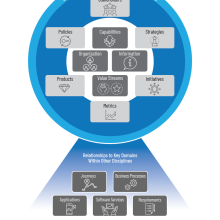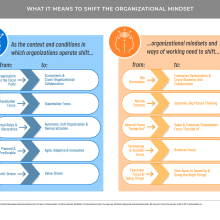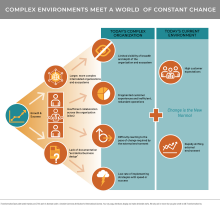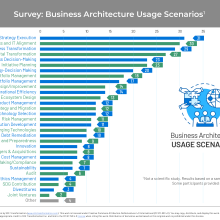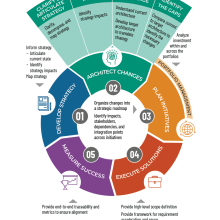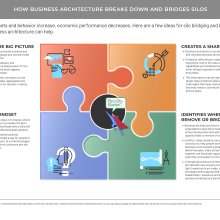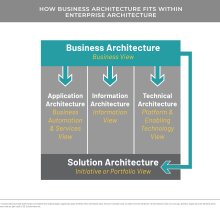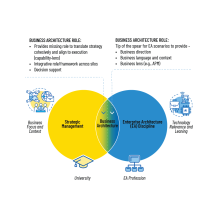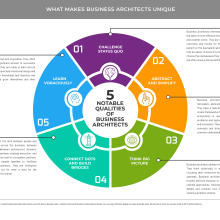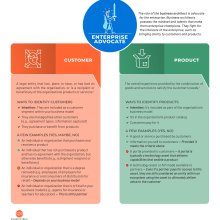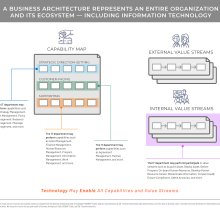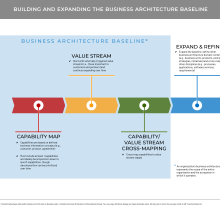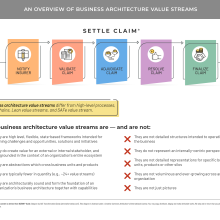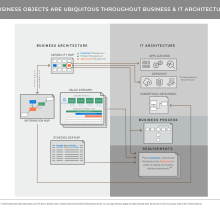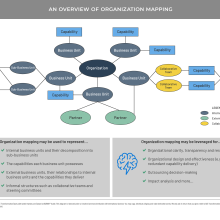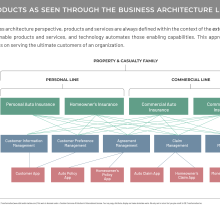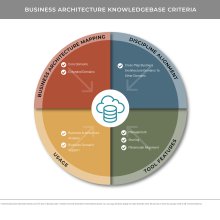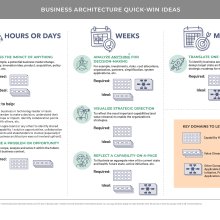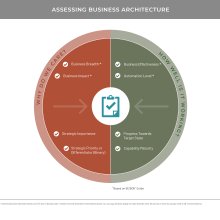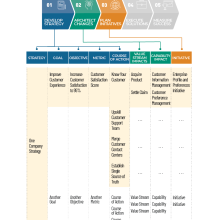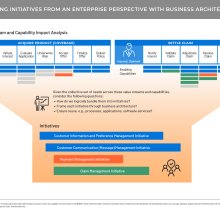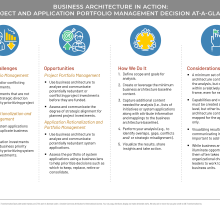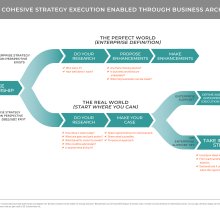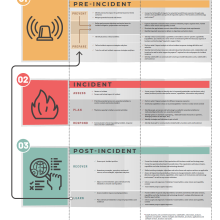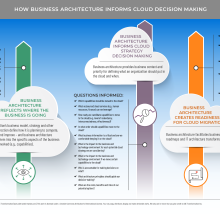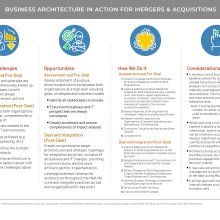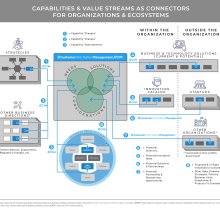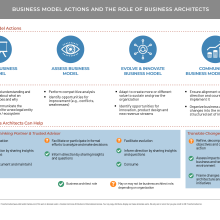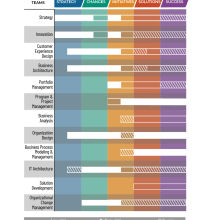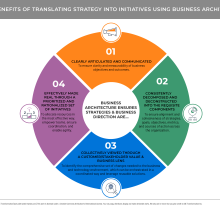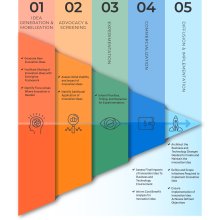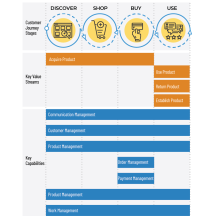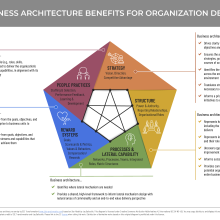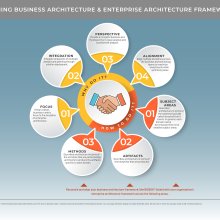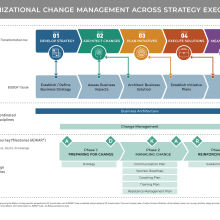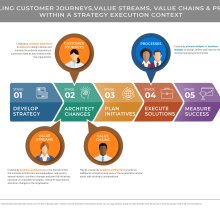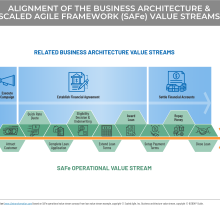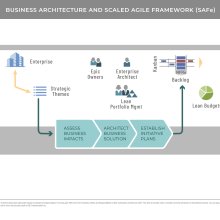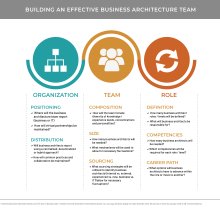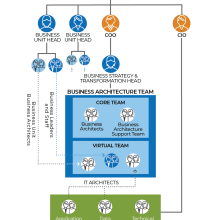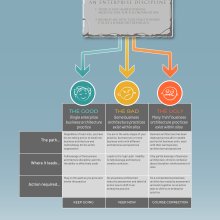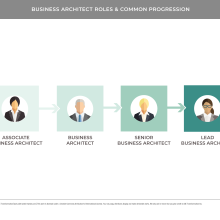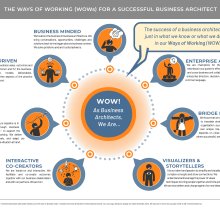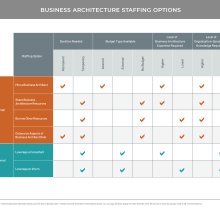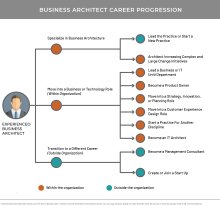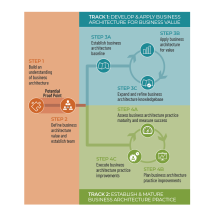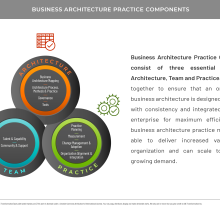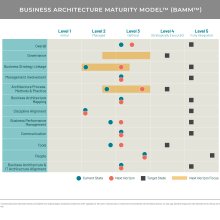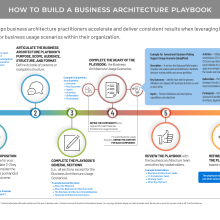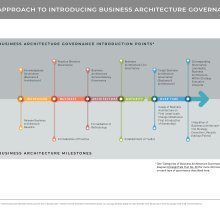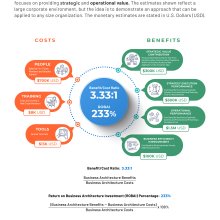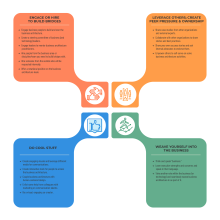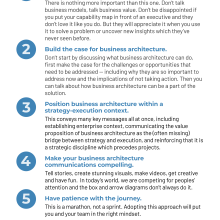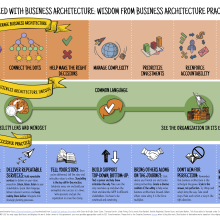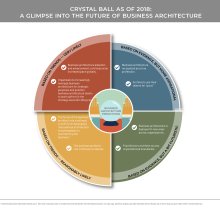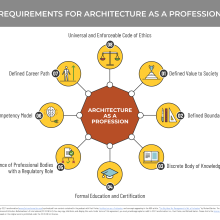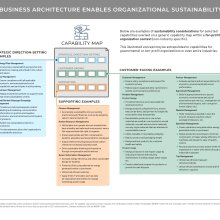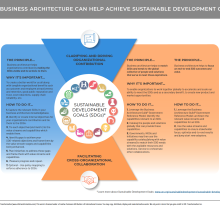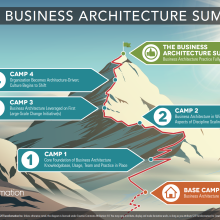CHAPTER ONE: Demystifying the What, Why, and How of Business Architecture
Figure 1.1: Business Architecture Domains and Key Relationships
Figure 1.1 from the book illustrates the ten domains represented by business architecture along with a few key related domains.
What it Means to Shift the Organizational Mindset
Business architecture may just be a blueprint of an organization, but because of its holistic nature, it encourages a shift in peoples’ mindsets and behaviors as they build and use it over time.
Complex Environment Meets a World of Change
The well-established organizations and institutions that exist today are still here because they succeeded. However, the complex state that many established organizations find themselves in has now collided with high customer expectations and rapidly changing market forces.
Survey: Business Architecture Usage Scenarios
The specific business usage scenarios for business architecture are only limited by the imagination. The more mature an organization’s internal business architecture practice becomes, the greater the scope and complexity of usage scenarios it can undertake. These survey results are representative of the increasingly strategic use of the discipline within organizations.
Figure 1.2: The Role of Business Architecture Across Strategy Execution
Figure 1.2 from the book depicts a high-level strategy execution framework with an overlay highlighting the role of business architecture.
You may have noticed that this image was the inspiration for the cover design of the book. You are right! The flow from strategy to reality is continual, and business architecture is the golden thread that runs through it.
How Business Architecture Breaks Down and Bridges Silos
Business architecture is an expert silo-buster. One of the key themes for business architecture’s role in strategy execution, and most other usage scenarios for that matter, is its unique role in helping to break down and bridge organizational silos.
How Business Architecture Fits Within Enterprise Architecture
Business architecture is part of the overarching discipline of enterprise architecture.
Figure 1.3: Business Architecture Lives in Two Worlds
Figure 1.3 from the book reflects the role business architecture plays as both part of strategic management as well as the enterprise architecture discipline.
What Makes Business Architects Unique
Business architects are truly unique and consistently so worldwide. While there is of course great variation from any one individual to another, there are a few very special characteristics embodied especially by business architects.
Business Architect Strengths Study Brief
Some initial research illuminates that business architects have some unique superpowers to be leveraged, particularly related to thinking. The first superpower is related to connectedness. Business architects are often non-linear thinkers and can see non-obvious connections between things and events that others might miss. The second superpower is related to intellection. Business architects bring wisdom and clarity to leaders and teams through their ability to think deeply into a challenge, idea, concept, or principle.
Read the Study Brief
CHAPTER TWO: Representing an Organization Through Business Architecture
Defining an Organization’s Customers and Products
In a business architecture, customers and products always reflect the external perspective. The customer-facing orientation of a business architecture is so important because it creates a crystal-clear understanding of the big picture, and it always brings us back to who we are ultimately serving: the customer.
A Business Architecture Represents an Entire Organization and Its Ecosystem – Including Information Technology
An organization’s IT department is considered a business unit just like any other. Every business unit plays an important role to deliver value to an organization’s customers and support its operations. IT is no different and no more or less special. An organization is united by one business architecture and that includes everyone.
Building and Expanding the Business Architecture Baseline
The minimum business architecture baseline includes three components: (1) capabilities, (2) value streams, and the (3) cross-mapping between them. Further refinement and expansion of the knowledgebase can occur just enough just in time.
An Overview of Business Architecture Value Streams
Value streams are high-level frameworks that describe how value is delivered from end-to-end to a customer, partner, or employee. Value streams help us focus on the things that create value, and they allow us to look at what an organization does from the perspective of its stakeholders.
Settle Claim Value Stream – Origami Style
Capabilities are cross-mapped to each stage within a value stream that they enable. As an example, the Settle Claim value stream is represented here origami-style with a breakout for the Claim Validation capability to highlight its related business units, processes, system applications, and policy.
Business Objects are Ubiquitous Throughout Business and IT Architecture
The information map provides a pure business perspective on how the business defines its information concepts and their relationships. Information concepts are ubiquitous throughout an organization’s business architecture.
An Overview of Organization Mapping
Business architecture provides a unique and politically agnostic take on organizational structure. It does not replicate the organization chart or include people, titles, or hierarchical management structure. Organization mapping is simply a representation of an organization’s business units (including how they decompose into sub-business units) and their relationships to other domains such as capabilities.
Products As Seen Through the Business Architecture Lens
Products represent both the tangible goods and intangible services that an organization offers to its customers. As mentioned, in a business architecture, the definition of products must always be customer-facing, never an internal definition of product. One of the most important relationships to make is the cross-mapping from products to the capabilities which enable them.
Business Architecture Knowledgebase Criteria
Fully supporting business architecture content is the essential foundation of a business architecture tool. Select a tool that is aligned with the BIZBOK® Guide metamodel. In addition to the core ability to support content in an industry-aligned way, a business architecture tool should support visualization and reporting. Beyond these major categories of requirements, assess the factors which one would consider for any vendor or tool, among them the intuitiveness and ease of the user interface and the ability to integrate with other tools.
CHAPTER THREE: Leveraging the Unique Value of Business Architecture
Business Architecture Quick Win Ideas
Initial business usage scenarios are good places to start at the beginning of a business architecture journey because they require minimal content and clearly demonstrate the potential of discipline. Quick wins are ways to leverage business architecture in hours, days, weeks, or up to three months and these are always relevant. Here are a few short-term but impactful usage scenarios which primarily leverage capabilities as the main framework for analysis, though other domains such as value streams may be used as well.
Assessing Business Architecture
There are two categories of capability assessment to consider: how well things work and why we care. While each aspect reveals valuable information on its own, they are often used in conjunction with each other to provide the full context for a situation.
Figure 3.1: The Golden Thread: Translating Strategy into Initiatives
Figure 3.1 from the book shows the golden thread which helps translate strategies into initiatives and measures the results delivered by those initiatives.
Scoping Initiatives From An Enterprise Perspective With Business Architecture
Architects bring many people together across the organization and across disciplines to help define the changes that will become initiatives. This is where new innovative and reusable solutions that would not have otherwise been envisioned can be realized. This is how initiatives become scoped in the most effective and non-overlapping way. This is where leaders step up to collaborate on initiatives, even if it pushes on business unit, product, or portfolio boundaries—because it is the right thing to do for the enterprise. This is what accelerates the downstream delivery because the right stakeholders are already identified up front as are the dependencies and integration points.
Business Architecture In Action: Project and Application Portfolio Management Decision Making At-A-Glance
Business architecture does not just shape individual initiatives but also informs initiative investments within and across portfolios, with an eye to what is best for the enterprise. This is one of the most common and valuable ways to leverage business architecture and is suitable as an initial usage scenario.
Creating Cohesive Strategy Execution Enabled Through Business Architecture
Here are a few practical steps to shift an organization’s approach to strategy execution. It is a journey, and it requires the hard work of formulating and sharing a vision for more effective strategy execution, partnering with other like-minded people, and working the change from within the organization day after day.
How Business Architecture Helps Organizations To Prepare For, Respond To And Recover From The Unexpected
Business architecture helps organizations prepare for and respond to the unexpected. Having a business architecture in place is one of the best ways to be prepared to respond to an incident. However, during the crucial time of responding to an incident, business architecture enables an organization to make more informed decisions, more holistic decisions, and quicker decisions.
How Business Architecture Informs Cloud Decision-Making
Business architecture provides critical business context to inform decision-making for cloud strategy and migration.
Business Architecture In Action For Mergers & Acquisitions
Business architecture is invaluable for assessing and implementing structural changes, including mergers, acquisitions, divestitures, and joint ventures. The blueprints of business architecture provide expanded decision-making support, and business architects are vital thinking partners to bring to the table.
Capabilities and Value Streams As Connectors For Organizations and Ecosystems
Business architecture facilitates ecosystem architecting and collaboration.
CHAPTER FOUR: Integrating with Other Teams and Disciplines
Business Model Actions and the Role of Business Architects
An organization’s business model is ideally created, evolved, innovated, and communicated through partnership between business leaders, strategists, and business architects. For a variety of reasons, business architects often take the role of stewarding an organization's business model documentation. However, everyone should be able to understand an organization’s business model and use it.
Figure 4.1: Team Involvement Across Strategy Execution
Figure 4.1 from the book provides an overlay of business architecture and other teams across strategy execution, including their level of involvement in each stage.
Four Benefits of Translating Strategy Into Initiatives Using Business Architecture
One of the most unique and compelling benefits of business architecture for strategy is that strategy content can be documented comprehensively in a reusable, shared knowledgebase. This greatly expands the options for strategic options assessment, strategy translation, and strategic alignment.
Leveraging Business Architecture For Innovation
Business architecture plays a role throughout the entire innovation life cycle to help generate, validate, disseminate, scale, and implement innovation ideas.
Figure 4.2: Alignment of Journeys, Value Streams, and Capabilities
Figure 4.2 from the book illustrates a simplified example of a retail customer journey, where value streams and capabilities can be assembled to deliver a cohesive, consistent experience for customers.
Business Architecture Benefits for Organization Design
Business architecture and organization design share many of the same goals for organizations: intentional design, organizational alignment, and agility and adaptability. As a result, tight partnership and integration between these two disciplines is essential and mutually beneficial. Business architecture contributes unique value to each of the five major components of organization design within the Star Model.
Aligning Business Architecture & Enterprise Architecture Frameworks
Regardless of the enterprise architecture framework that an organization uses, the business architecture framework as described in the BIZBOK® Guide can be aligned with it. For example, the IT architecture domains may remain the same, but any business architecture domains replaced by the ten domains and their relationships as defined in the BIZBOK® Guide metamodel. The ecosystem-wide and strategic philosophy and positioning for business architecture should also be adopted.
Organizational Change Management Across Strategy Execution
Change managers and business architects partner closely, especially to assess the potential scope and impacts of change early on. Change managers consume business architecture to help assess change impacts and inform the change management strategy.
Untangling Customer Journeys, Architecture and Process Within Strategy Execution Context
On the surface, customer journeys, value streams, and processes may all seem like the same flows, but they differ in why they are created, when they are created, who creates them, and how they are created. Each representation is fit for purpose, so it is important to understand their intentions, where they apply within an enterprise context, and how they fit together.
Alignment of The Business Architecture and Scaled Agile Framework (SAFe) Value Streams
Within the Scaled Agile Framework®, SAFe value streams are a primary construct used to organize and deliver value. Operational value streams are closer to business architecture value streams. However, SAFe value streams are based on guidelines, which are widely interpreted in practice and are often scoped to represent entire lifecycles. This means that multiple business architecture value streams may apply across one SAFe value stream.
Business Architecture and Scaled Agile Framework (SAFe)
Business architecture and agile approaches both care about the delivery of value and the achievement of business outcomes, with improved time to market. Business architecture contributes unique value on both fronts to enhance SAFe and agile efforts. It also provides the underlying business framework.
CHAPTER FIVE: Maximizing the Business Architecture Team
Building An Effective Business Architecture Team
There are three considerations when designing a business architecture team: organizational structure, the team, and the role.
Figure 5.1: A Best Practice Business Architecture Team Structure
Figure 5.1 from the book reflects a best practice hybrid business architecture team structure.
Guidance For Establishing A Business Architecture Practice: The Two Immutable Principles
Regardless of how business architects are distributed across an organization, a cohesive business architecture practice can thrive if the two immutable principles are followed: there should be one shared business architecture for an organization and one business architecture methodology shared by practitioners. This will facilitate an enterprise view and mindset and ensure that architects have a common education and frame of reference.
Business Architect Roles and Common Progression
A common progression of roles starts with the business architect, followed by the senior business architect, followed by lead business architect that is the most experienced. Organizations may create multiple levels within each of these roles as well.
Table 5.1: Key Competencies for Business Architects
Table 5.1 from the book reflects key competencies for business architects, organized into three distinct categories.
The Ways Of Working (WOWs) For A Successful Business Architect
The success of a business architect lies not just in what they know and do, but in how they show up. Working in ways that are engaging, contemporary, and relevant help business architects get invited to the right strategic tables to deliver the value proposition for which business architecture is intended. Here are a few characteristics encapsulate how successful business architecture practitioners think and act.
Business Architecture Staffing Options
Experienced business architects are in high demand, and the fact that business architecture is still an emerging discipline makes the pool of practitioners even smaller. This means that finding great business architects can require some creativity. Here are a few places to find great business architects.
Business Architect Career Progression
Once a business architect has truly mastered the role and reached a high level of competency, there are many possible career path options they can pursue. A successful business architect can shift their career in the direction they desire, either making the business architect role a long-term career choice or a step in a larger journey.
CHAPTER SIX: Building an Internal Business Architecture Practice
Figure 6.1: A Roadmap for Building a Business Architecture Practice
Figure 6.1 from the book shows the approach to establishing and maturing a business architecture practice, comprised of two tracks, guided by delivering business value.
Business Architecture Practice Components
There are a finite set of components that are essential to any business architecture practice. They can be measured through a business architecture maturity model and serve as a checklist to be addressed over time as a practice grows. Each component should be considered during business architecture practice planning and roadmap development.
Business Architecture Maturity Model® (BAMM®)
The business architecture maturity assessment and business architecture practice roadmap are the two key tools that can help an organization to deliberately mature its practice over time. A business architecture maturity assessment measures the progress of an organization’s business architecture practice against an objective business architecture maturity model standard. A business architecture practice roadmap reflects the specific enhancements to be made to achieve the target maturity levels for the next horizon.
How to Build a Business Architecture Playbook
A playbook allows a business architecture team to scale faster. It is an excellent tool for onboarding and training new business architects that join the team. It helps to facilitate team collaboration and best practice sharing on an ongoing basis. It also helps a business architecture team to deliver better. It ensures that business architects deliver business architecture services efficiently and consistently—and that those services also achieve the intended business outcomes.
An Approach to Introducing Business Architecture Governance
Business architecture governance should exist to provide business value and ensure outcomes—not create unnecessary bureaucracy. The establishment of business architecture governance should be approached practically and incrementally, focused only on activities that provide business value. Each aspect of business architecture governance should be introduced over time as key milestones are reached, making them relevant.
Table 6.1: Types of Business Architecture Governance
Table 6.1 from the book describes potential types of business architecture governance.
Table 6.2: Sample Business Architecture Measurement Ideas
Table 6.2 from the book provides a sample of simple ideas to measure business architecture value and maturity.
Calculating Return on Business Architecture Investment
Return on Business Architecture Investment (coined here as ROBAI) is a tangible and familiar measure that does speak to people. Tracking the ROI of a business architecture practice gives the team transparency and accountability for the value they deliver to the organization. In addition, communicating the ROI of a business architecture practice can help to build support for the discipline within an organization and worldwide.
Socializing and Building Adoption for Business Architecture
Here are a set of practical tips, best practices, secrets, and hacks for business architecture socialization that work. For the socialization techniques to work well though, an organization must have a clear, simple, relevant, and consistent value proposition for business architecture. Remember the secret to socialization: this is not about the business architecture, this is about the business.
Five Tenets of Socializing Business Architecture
Here are five tenets of socializing business architecture.
How To Succeed With Business Architecture: Wisdom From Business Architecture Practice Leaders
While there are not yet any easy routes to the top of the business architecture mountain, there is a set of practical tips, best practices, secrets, and hacks for business architecture socialization that work, based on the collective wisdom of business architecture practitioners around the world. Interviews with nine business architecture practice leaders are summarized here in this infographic. Please also see the article based on these interviews along with the corresponding podcasts contained within.
CHAPTER SEVEN: Shaping the Future of Business Architecture
Predictions About the Future of Business Architecture
Based on the current state of business architecture state and growing trends, here are a few predictions for how the discipline and role will unfold over the next horizon.
Requirements for Architecture as a Profession
Industry professional organizations must continue to work towards creating a common foundation for a true architecture profession (with specializations by domain).
Business Architecture Enables Organizational Sustainability
Business architecture is a comprehensive framework to assess, analyze, monitor, and communicate an organization’s sustainability performance. Sustainability metrics and considerations can be tied to capabilities (and value streams) to ensure that measurement is framed and communicated within shared business context and priorities.
How Business Architecture Helps Achieve Sustainable Development Goals
In our connected world, achieving the United Nations (UN) Sustainable Development Goals (SDGs) is important to all of us. The goals not only ensure that everyone’s basic rights are met, but they also help to create stable and successful nations with economic growth, social trust, fairness, equality, and sustainability. Stable and successful nations in turn create a strong global market for us all. Business architecture makes the achievement of the UN SDGs actionable, measurable, visible, and possible—within and across organizations.
A Final Summary and Some Inspiration
Business Architecture Straight Talk: 100 Insights to Guide the Journey
Here’s a compilation of 100 bite-sized insights learned from years of pioneering and practicing the discipline, to help propel our business architecture journey into the future—written in true StraightTalk style. Also available as a tweet thread.
Conquering The Business Architecture Summit — Lessons from the Mountain for Establishing a Business Architecture Practice
Here’s one final passion piece. Establishing a business architecture practice is a journey of passion, persistence, and reward. Inspired by almost two decades of helping organizations to mature their practices—combined with personal mountaineering experiences—internationally-recognized business architect and thought leader, Whynde Kuehn, shares a vision of what is possible and some wisdom on how to get there, using a mountain as a metaphor. There are many parallels between the two, especially as business architecture practitioners and leaders are by far some of the most determined and passionate people on the planet, according to Kuehn. See you at the summit, my friend.
Conquer the Business Architecture Summit

